The smartphone industry continues its all-out war for camera supremacy, with brands trying to cram as many pixels in as many cameras as possible. From those paltry 2-megapixel macro and depth cameras to the 108-megapixel snappers on phones like the Galaxy S22 Ultra, the numbers only seem to go up.
Soon, Samsung’s 200-megapixel camera sensor will take things to the next level, but at the heart of all this megapixel wizardry is a technology called pixel binning — and it’s key to a camera’s success. However, not all pixel binning is the same. Samsung uses “tetra” 4-in-1 pixel binning on the Galaxy S22, and “nona” 9-in-1 pixel binning on the Galaxy S22 Ultra. Does all this make any difference? We found out.
Why pixel binning is necessary
What does pixel binning do? In short, it allows adjacent pixels to work as one large “super pixel,” collecting more data to deliver brighter photos with more accurate colors and less noise. Before we get into the technical details, it’s important to understand why it happens in the first place.
The camera sensor on your phone is the component that collects and processes all the optical information fed to it by the lens in front. The sensor, in turn, is essentially a plate of pixels. Millions of them, actually. Just like cells on a plant, pixels absorb the light, which then undergo signal conversion to produce the image we see on our phone’s screen.
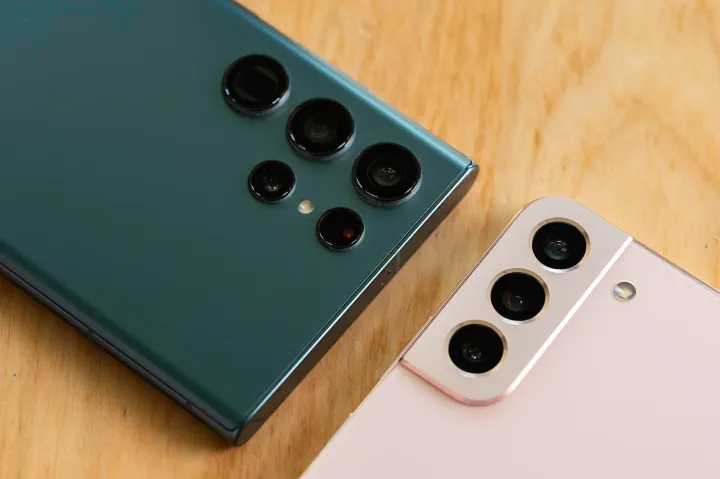
But here’s the odd part. The higher the number of pixels there are, the higher the resolution of the image — allowing more details and sharpness. However, as we keep adding more pixels, the size of sensors should also increase to accommodate them. Going from 10MP to 200MP should result in a 20-times larger camera sensor. But because there’s limited space available inside a smartphone’s chassis to fit image sensors, that size increase can’t happen.
To solve the problem, the size of pixels is shrunk, fitting more of these photosensitive elements on the sensor plate without increasing its size too much. However, the smaller a pixel gets, the worse it gets at absorbing light — resulting in lackluster details and colors. That’s where the pixel-binning tech comes to the rescue by algorithmically creating larger pixels that are capable of absorbing more light. When this happens, you get better-looking photos.
Pixel binning benefits are easy to see
When this algorithm kicks into action, a larger super pixel is created that absorbs more light data. This is especially important in lowlight environments where the camera sensor needs to collect as much light as possible. In the case of tetra pixel binning on the Galaxy S22, when four neighboring pixels of the same color are merged into one, their light sensitivity is increased by four times.

As a result, the pixel-binned photos turn out brighter with higher sharpness and greater contrast. The image above was captured at the native 50MP resolution of the Galaxy S22’s primary camera. Notice the level of grain and blurry edges. Below is a pixel-binned 12.5MP shot of the same subject captured by the S22, offering well-defined lines and much better color reproduction, with a brighter profile around the edges.
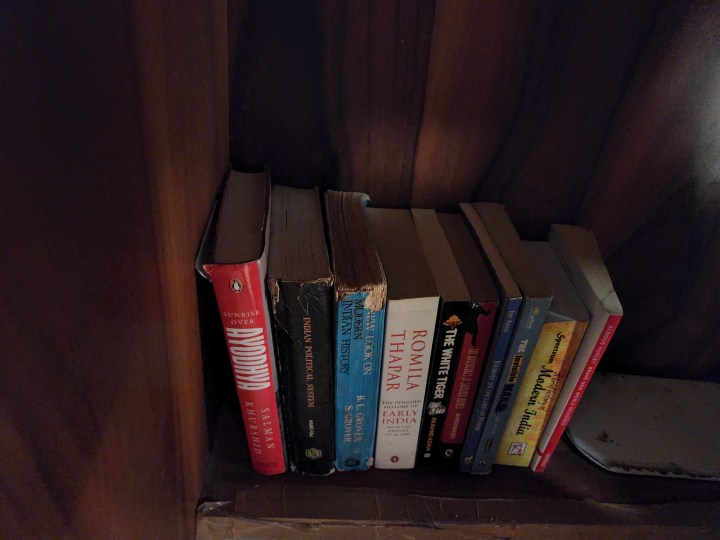
But the benefits of pixel binning are not limited to lowlight photography. In fact, the tech also elevates the HDR (High Dynamic Range) output. When taking pictures of a high-contrast subject or surroundings, the pixel-binning tech again produces tangible benefits.
Each pixel group (based on its color) has a different level of photosensitivity and exposure time, which means they collect light information in a segmented form and with higher precision. As a result, when HDR processing is applied to the optical data collected by each pixel array, the photos look punchy, with higher color accuracy and improved dynamic range.
Samsung’s different approaches to pixel binning
The scale of pixel binning depends on the number of pixels themselves. For example, a 48MP camera combines four pixels into one artificially enlarged super pixel to deliver 12MP photos. That’s why brands market it as 4-in-1 pixel binning. Similarly, camera sensors with 5o million or 64 million pixels produce 12.5MP and 16MP images, respectively. In Samsung’s marketing lingo, you may come across the name “Tetracell” to define this process.
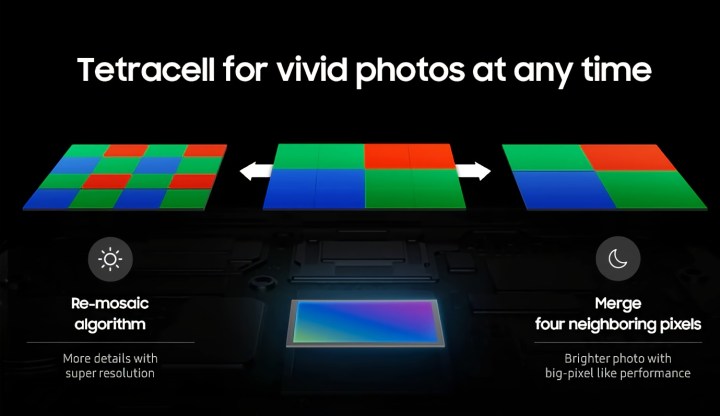
On a technical level, pixels don’t actually move or combine physically. Instead, it is done on a software level using remosaic algorithms. The individual pixel arrangement continues to be the usual RGB affair. Tetracell’s job is to group pixels with the same color filter next to each other in a 2×2 pixel array and merge them to create a larger artificial RGB pixel array for collecting more light. Take a look at the image above to see how it turns out.
The 50MP camera on the Galaxy S22 employs 1-micron pixels, but when the pixel-binning tech kicks into action, it merges a 2×2 array of adjacent 1-micron pixels. This gives us a larger super pixel that measures 2-microns across. This is the tetra method. But when you have a 108MP camera on a phone like the Galaxy S22 Ultra, the size of pixels gets even smaller.

Instead of 4-in-1 pixel binning, this 108MP sensor relies on what Samsung calls “Nonacell” tech. It combines nine neighboring pixels into one. This merger of a 3×3 pixel array creates a larger super pixel that is 2.4-microns in size. In doing so, the resolution comes down from the native 108MP to 12MP, but the photos turn out brighter with better color accuracy. This is the nona pixel binning method.

As mentioned above, smaller pixels struggle with collecting light data, hence they lose out on details in photos. The above left image is a segment from a full-resolution 108MP picture taken by the Galaxy S22 Ultra’s primary camera sensor, which comes with smaller 0.8-micron pixels. On the right is a segment cropped from a 50MP shot taken by the Galaxy S22’s main camera, which packs larger 1-micron pixels. Owing to larger pixels, the Galaxy S22’s camera sensor collects more light data, and as a result, you can see more details on the leather bracelet, with improved sharpness and far better exposure.
However, when pixel binning kicks into action, the Galaxy S22 Ultra’s camera sensor creates a larger 2.4-micron super pixel that collects more light data than the Galaxy S22’s primary camera, which artificially creates a smaller 2-micron super pixel. Unsurprisingly, the results are reversed.
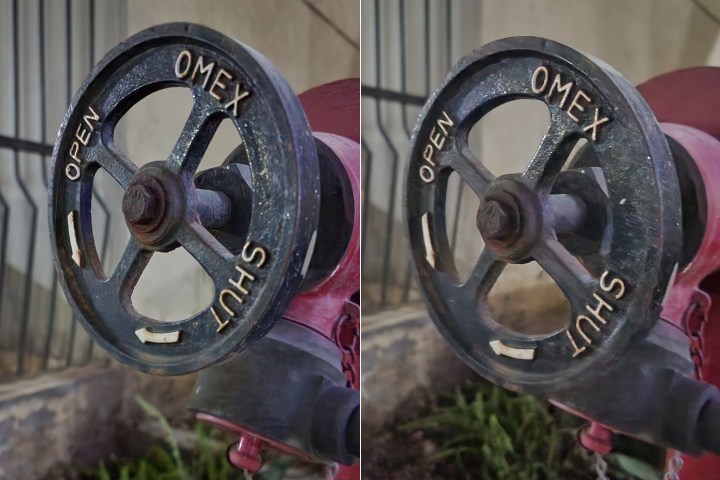
As you can see in the image above, the Galaxy S22 Ultra’s larger super pixel offers improved subject separation with higher control over sharpness, more surface details, and better color accuracy. But pixel binning isn’t solely about bringing out details in lowlight. It also plays a huge role in reproducing colors, managing dynamic range, and other crucial parameters.
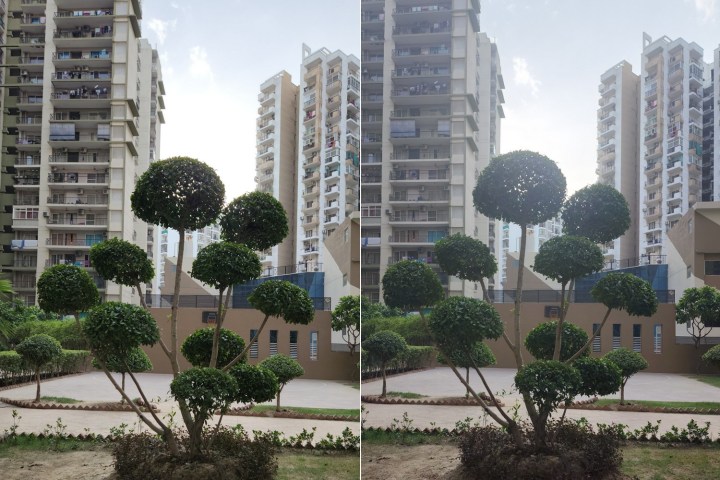
In the image above at left, the Galaxy S22 does a much better job at subject exposure, depth estimation, and color reproduction in a full-resolution 50MP shot, compared to the 108MP snap of the same scene from the Galaxy S22 Ultra. The smaller pixels on the Galaxy S22 Ultra’s primary camera result in washed-out colors on the buildings and an overall less punchy profile.

Just like the lowlight scenario, pixel binning again highlights the difference and flips the results. Thanks to the larger super pixels created by the Galaxy S22 Ultra’s camera sensor, the image on the right above captures depicts the brick grooves more accurately in the picture and the colors turned out closer to reality than in the picture taken by the vanilla Galaxy S22. However, it is worth pointing out here that pixel binning is not the sole factor in deciding image quality. A lot depends on the sensor’s make, the underlying algorithms, and aperture, among other factors.
The future of pixel binning on smartphones
With no end to the pixel wars in sight, the next evolution is 200MP camera sensors. In fact, Motorola is rumored to launch the first phone rocking such powerful imaging hardware. In this case, the remosaic algorithms are going to combine no less than 16 pixels into one large unit. Take for example Samsung’s own 200MP ISOCELL HP-1 sensor, which introduces a new hybrid form of pixel binning.
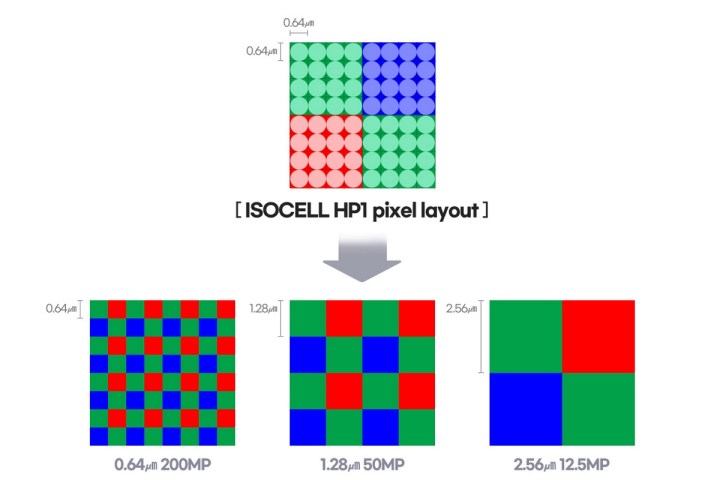
Depending on the lighting situation, it performs a hybrid 4×4 pixel-binning process that happens in two stages. First, the sensor performs 4-in-1 binning that involves a 2×2 array of 0.64-micron pixels. This creates a larger super pixel that measures 1.28-micron and produces photos at a 50-megapixel resolution. Next, the sensor does another round of 4-in-1 binning that involves a 2×2 array of 1.28-micron pixels, creating an even larger super pixel that measures 2.56-microns. At the end of this process, the final image resolution drops to a manageable 12.5-megapixels.
Therein lies why pixel binning is so necessary. As smartphone camera sensors keep getting more and more pixels, the need for quality pixel binning becomes all the more important. And it’s a technology that’s constantly evolving. Whether it be tetra, nona, or the hybrid pixel binning mentioned above, companies are still figuring out which methods work best for different cameras.



